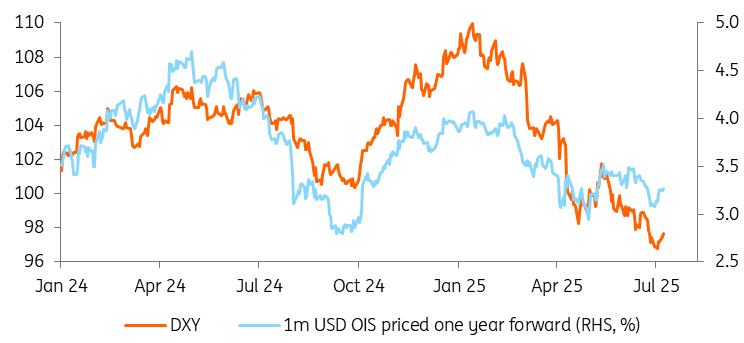Gold has topped $4,200. Here’s why Yardeni thinks the rally could go even higher.
The US dollar downtrend is pausing for breath. Fresh updates on US tariff levels are having a diminishing marginal impact on FX markets, and instead, macro factors are making a comeback. Here, we think the expected pick-up in US prices during the third quarter can deliver a counter-trend dollar bounce
Sticky Prices and an Independent (LON:IOG) Fed Can Help the Dollar
The trade-weighted dollar has fallen by 12% over the last six months. That’s a very sizable move and one to match the extremes seen this century. A quick summary of what got us here is: (January-March) rotation into international stocks and fiscal expansion in Europe, (April) surging US tariffs undermining US asset markets, (May-June) softening US price data and a view that the Fed would respond with earlier cuts.
Notably, recent news about the flip back to higher US tariff rates has not hurt the dollar. Indeed, recent dollar price action suggests short positions are getting a little stale. But with diminishing marginal reaction to tariff news, it looks like the macro story is going to have a greater say.
Here, our call for the next quarter is that higher US tariffs will finally show up in US inflation – something that the prices paid components of business surveys have been warning for a while. This data should play into the hands of the majority of the FOMC members who favour caution when it comes to restarting the Fed easing cycle. Our house call for the Fed to wait until December before cutting rates should be a dollar positive. In effect, we can see a reversal of the decline in short-dated US rates which hit the dollar in June. We think the dollar could be due a 2-3% corrective bounce in the third quarter as the Fed continues to resist White House pressure to cut rates.
Back-Up in Short-term Rates Could Help the Dollar

Source: ING, Refinitiv
G10 Low-Yielders in Focus This Month
If the dollar is to show a little stability this month, the focus may also shift to developments overseas. Here, Japan is interesting. Upper House elections on 20 July and what it means for Japanese fiscal policy is starting to have an impact on the yen. Instead of rising Japanese Government Bond yields helping the yen, the sell-off in Japanese bonds is starting to be treated like events in the US in April – a net negative for asset markets and the currency. A combination of firmer US short-dated rates and some sovereign risk in Japan could make USD/JPY at 150 the surprise package this month.
Elsewhere, we think there’s little the Swiss National Bank can do about the super-strong Swiss franc. Heavy FX intervention to resist franc appreciation is politically difficult during current trade discussions with the US, while the SNB’s room to cut rates may be limited too. That’s why we think the Swiss franc is a popular currency amongst investors – seen as a hedge should current benign global conditions not last.
For EUR/USD itself, we’re looking for a correction back to the 1.15 area this quarter. But we’ve nudged our year-end forecast higher and expect the dollar downtrend to resume towards year-end when the Fed cuts by 50bp and all those buy-side investors with US exposure are offered cheaper dollar hedging costs.
***
Disclaimer: This publication has been prepared by ING solely for information purposes irrespective of a particular user’s means, financial situation or investment objectives. The information does not constitute investment recommendation, and nor is it investment, legal or tax advice or an offer or solicitation to purchase or sell any financial instrument. Read more
